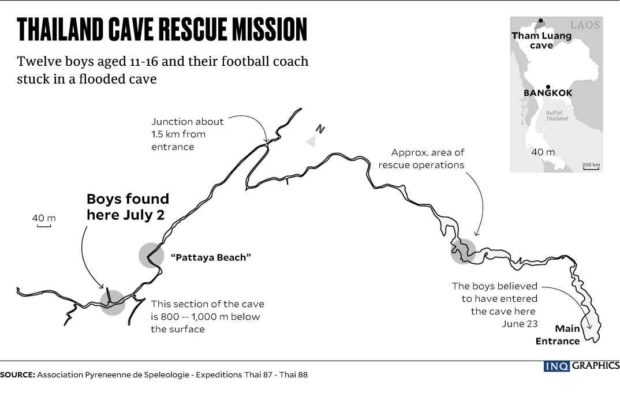
Dwindling oxygen levels in the cave complex and weather forecasts predicting more heavy rain added to the pressure on authorities to work out a rescue plan.
Samarn Poonan, 38, a former member of Thailand’s elite navy SEAL unit, died on Thursday night as he worked underwater in the cave complex, laying oxygen tanks along a potential exit route, the SEAL commander said.
“We won’t let his life be in vain. We will carry on,” Adm. Arpakorn Yuukongkaew told reporters on Friday.
Samarn was working with a partner placing oxygen tanks in a section of the cave. As they returned, Samarn fell unconscious about 1.5 kilometers from the cave entrance.
“Once his mission was over he dove back, but in the middle of their return his buddy found Samarn unconscious in the water and tried to pump his heart, but he could not save his life,” the SEAL unit said in a statement.
‘Many things could go wrong’
The diver’s death also highlighted the risks for the boys, who have no scuba diving experience, if authorities decide they should attempt to swim out of the flooded cave.
“A navy SEAL just passed away last night. How about a 12-year-old boy that will have to pass through?” said Rafael Aroush, an Israeli living in Thailand and volunteer at the site. “There will be rain and many things could go wrong. I don’t want to say it, but it could be a catastrophe.”
Officials warned on Friday that oxygen levels inside the cave have fallen and rescuers were racing to get more oxygen pipes into the cave. They have been working on a 5-km “oxygen pipeline” to prepare for the group’s extraction.
Alternatives
The boys, aged between 11 and 16, and their assistant coach were found inside the Tham Luang cave in northern Chiang Rai province on Monday, after nine days underground. They went missing after setting out to explore the cave on June 23.
Rescuers, including international teams, are pondering other ways to bring the group out before heavy rains hit the country’s north next week which could further hamper the rescue operation.
Alternatives include teaching the boys to dive and then swim out, a highly risky venture, remaining in the cave for months until the wet season ends and floodwaters recede, or drilling a shaft into the cave from the forest above.
Rescuers have been slowed by logistical issues, including high water levels inside the cave and narrow, flooded passages which would require the boys to dive alone. The navy is teaching the boys the basics of diving, with a view to guiding them out through floodwaters.
But getting them out won’t be easy. The boys will have to be taught how to use scuba diving gear and how to navigate a cave that has frustrated even the most expert divers. Some of the boys cannot swim.
Rescuers are considering other options including keeping the 13 inside the cave until the floodwaters recede at the end of the rainy season in about four months.